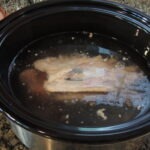There have been many articles written about planning large Thanksgiving feasts, but what if you’re only cooking for 4 to 6 people, or even 2? What’s the best approach if you have limited resources and a finite kitchen? Here are some general tips to consider as you start to plan your menu a few weeks before the big event. Also see our Thanksgiving Day Sample Menu.
- Appetizers: Your day will possibly start with appetizers. We suggest you keep this simple and not too filling since most people want to save room for the main meal. However, this really depends on the timing of your guests’ arrival and when you plan to serve the meal. You’ll need to consider what appliances and utensils will be available for heating or cooking hors-d’oeuvres if you choose to make something hot like Jalapeño Poppers. We usually keep it simple and make a dip like Classic Hummus the day before and serve it with raw vegetables and crackers, along with a few cheeses. Boiled shrimp with cocktail sauce or a Southern Relish Tray are also easy appetizers. Before we go any further, this is a good time to remember that you should NOT feel compelled to provide every single part of the menu. Many people love to bring a dish, so don’t be shy about asking. Appetizers are one of those items guests enjoy bringing, but don’t ask your chronically late family members to do so. They’ll be better off bringing dessert!
- Main Dish: Of course, turkey is the usual star of the meal, but there are other options for a small gathering. We’ll discuss each here.
a) Turkey. If you can’t imagine Thanksgiving without a turkey, but don’t want to eat turkey for the next month, there are several options.
– Order a small turkey from the grocery store or local butcher. You will have to accept a size range, probably 8-10 or 8-12 pounds. Small turkeys are hard to come by, so make sure you order one.
– If that still sounds like too much turkey, pick up a breast or drumsticks. Talk to your grocery store butcher or manager to find out if you should or could order these.
b) Chicken. If you’re a little more flexible, consider roasting a chicken. See How to Roast a Chicken and our recipe for Lemon Pepper Roasted Chicken.
c) Other/Vegetarian. Skip the turkey altogether and start your own tradition. This can be another meat-centered meal or a vegetarian option. Depending on your and your guests’ preferences, you might need to offer both options. That’s why we like to include dishes that can serve as both a side and as a vegetarian main meal, like Shepherdless Lentil Pie, Zucchini Medley with Polenta, or Cabbage and Potatoes. - Stuffing/Dressing:
a) If you’re serving turkey, you’ll need to choose a stuffing recipe, most of which use a cornbread base, a wheat bread base or a combination of both. Also, some stuffing recipes use rice or another grain as the base. Find out from your guests if you need to serve a gluten-free option. If you’re using a bread-based stuffing (either corn or wheat), you can make or buy the bread well in advance and freeze it, or just pick some up at the store a few days before. Either way, you’ll want the bread to dry out before you mix up the dressing. Check your recipe so you’ll have enough time to prepare the bread as indicated. We like cornbread stuffing, personally, but our Cheesy Rice Casserole is a nice gluten-free option.
b) Next, you’ll want to decide if you’ll stuff the turkey or cook the stuffing in a separate dish. We do not recommend stuffing the turkey. The turkey and stuffing will cook more thoroughly when prepared separately, reducing any possibility of food contamination. Also, your turkey will end up crisper on the outside and more moist on the inside when cooked without the cavity filled. If you want extra turkey flavor in your stuffing, add some of the juices from the cooked turkey.
– Note that you might not have room to cook both of these items at the same time. We suggest preparing and cooking the stuffing in your 8×8-inch baking dish the day before. Once the turkey is done, remove it from the oven, and scoop out a few tablespoons of the juices. Drizzle over the top of the cooked stuffing and heat thoroughly in the oven at 375°F until hot and crispy on top. If you need the baking dish for another recipe, transfer the cooked stuffing to your glass mixing bowl, stir in the turkey juices and reheat in a microwave. - Small Stuff: There are a few small sides that are easy to forget in the rush of things, but should not be neglected – gravy and cranberry sauce.
a) Gravy is much easier to make than you might think. You can skip it if your meal is vegetarian, but turkey and dressing just don’t seem complete without gravy. Although we steer clear of most prepared (canned and bottled) gravies from the grocery store, some stores like Whole Foods sell decent turkey gravy made in the store, if making gravy intimidates you. (But like we said, it’s really easy to make.)
b) Cranberry sauce is one of those foods people love or hate. Try making a fresh cranberry sauce with oranges and herbs, which is healthful and equally delicious with turkey or potatoes. - Side Dishes: We love vegetables, especially at holidays. Our biggest problem is deciding what not to cook, since we have limited space, time, and cookware. For Thanksgiving, we try to include at least:
a) One potato-based dish, or other starchy item. This might be one of the casseroles mentioned earlier or mashed potatoes, squash or a grain. (Rolls are another category in our home.)
b) One green vegetable. We often include more than one just because we’re vegetable fanatics, but that’s up to you. We like green beans, broccoli, cauliflower (even though it’s not green), Brussels sprouts, etc. Our recommendation is to keep this one simple since you’ll probably have to cook it last minute.
c) One salad. Depending on the other choices, we’ll add a mixed salad, coleslaw, or some type of vegetable salad. Make this in the morning if possible.
c) Fruit. Here, we fall back on family tradition. Rebecca and Greg’s paternal Grandma always served a first course to the Thanksgiving meal, which was a small bowl (or fancy parfait glass) for each person, filled with fresh orange and grapefruit segments. Their maternal Nana served Pink Stuff, a strawberry, jello and whipped cream dish, which we’ve revamped and renamed Pink Fluff, which we serve with the main meal, not as a first course. A mixed fruit salad is another good option.
d) Bread. In our home, bread was one of the stars of the meal. It was a time to enjoy homemade rolls, which very few people take the time to do anymore. You might not have the equipment or time to accomplish this, which is understandable. If you want to try, you can make them a week or two early, then freeze them until they are ready to be thawed and reheated. To free up baking dishes, we’d suggest wrapping them in foil after they’ve cooled, then storing them in a plastic bag to freeze. Thaw and reheat them in the foil. If you can’t imagine baking your own bread, there are many wonderful artisan breads and gluten-free options available now at bakeries and stores, so don’t worry! There’s no need to stress over the bread option. - Dessert: By now you should feel stuffed just thinking about all of this! However, we can’t end without dessert. We usually make cookies and a pie, but whatever you make, choose something you can do ahead of time and still have the necessary cookware free for other uses… or ask a guest to bring it. We keep an extra 8×8-inch baking dish around so we can make our Pumpkin Pie Squares!


[…] a follow up to our previous post on How to Plan Your Thanksgiving Menu for a Small Gathering, here’s a sample menu in which we provide a number of choices AND a vegetarian option. We […]